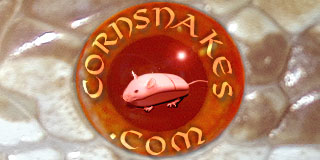From my retired SerpenCo.com website.
Motley Corn Snake
The first Motley Mutant Corn Snakes (as they were originally called) were at Dr. Bernard Bechtel's place sometime back in the early '80s. I was fascinated by the patterns they exhibited and the variability between individuals. Some had large odd shaped saddles and others had broken stripes, whereas others had perfect rows of circles directly down the center of the back. All had completely patternless abdomens that were a cream color and sometimes a striping effect along the sides.
Subsequently, other pockets of this mutation popped up in several other people's collections later on in the '80s, and later breeding trials proved that it was the same genetic line. There does seem to be a link with this trait and the Striped Corns, but the exact relationship concerning a single line of ancestry is not clear.
My original specimen of this line is a cherished gift from Dr. Bechtel back in 1988. Apparently Dr. Bechtel felt he should repay me for some favor I had done for him in the past, although nothing of the sort was necessary. I felt it was an honor that he would even ask for my help with anything. If you have never met Dr. Bechtel, you really should do so. You will soon see that you would no more think of denying or ignoring his request for something than you would to cut off your own finger. He is the Godfather of corn snakes and it has been his work with the corn snake that has fueled most of the interest that has brought so many amazing things to light in this field.
The original Motley I got from Dr. Bechtel is a classic example with a row of lighted colored spots down the back, lateral striping, and a uniformly light colored abdomen. Her blood line has fueled most of the other variants of motley I am working with. Whenever I decided to use a Motley line in a new project, this one animal is the one I chose for the base stock. And I have never been disappointed with the results.
Whereas babies and young examples of this cultivar can often be very contrasty looking animals, many of the adults can become rather uniformly colored with little contrast between the ground color and the blotches. Projects are in the works to increase this contrast, and even something as simple as a Miami Phase Motley tends to produce animals that are very pleasing to the eye.
There are a few mysteries attached with this cultivar. One is that the coloration appears to often be a more burnt orange coloration in many individuals, and can often infuse a substantial color drift in projects they are used in. Another is that there appears to be a wild card form of Hypomelanism floating around in this cultivar. Many of the Motley line will appear to already be Hypomelanistic, with little or no black markings on them, and some will naturally be lighter than others from the same clutch. This became much more evident as I outcrossed Motleys into other genetic lines. In both the Milk Snake x Motley and the Caramel Motleys, there are some individuals that are substantially different from others of the same line. The problem is that this particular form of Hypomelanism is unlike the typical form we are used to working with. In typical Hypomelanism, if you have a clutch of babies and a few are Hypomelanistic, they stand out like sore thumbs in the clutch. There is no doubt at all about which are which when you compare them with their normal colored siblings. However, as adults, it can sometimes be rather tough to tell which ones are Hypo and which ones are not. With this other form of Hypomelanism that appears to be in the Motley line, the exact opposite appears to be taking place. Babies will all look basically the same, but by the fourth or fifth sheds, some will appear to be getting substantially brighter colored than the rest. Some dramatically so. I am even hesitant to refer to this as 'Hypomelanism' as this seems to be more of a color brightening agent rather than a mere reduction of black pigment. A lot more work needs to be done in order to isolate and cultivate this genetic trait (if in fact it is genetic), to explore it's potential.
